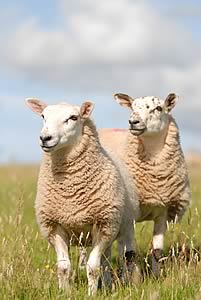| 2009-08-21
The lower domestic slaughterings and favourable sterling exchange rate that underpinned the far better market for lambs in the first half of this year are expected to continue in 2010, according to the latest market outlook from EBLEX, the industry body for beef and lamb levy-payers in England. Short term factors, though, may keep conditions less firm than many producers might like over the next six to nine months.
While the normal seasonal trend of supply and demand, complicated by particular exchange rate volatility, will continue to have the greatest impact on lamb values, the supply side of the market looks set to tighten still further in 2010 as the national breeding flock continues to contract.
Indeed, the 5% year-on-year decline in the UK breeding flock revealed by the December agricultural survey is forecast to reduce the current lamb crop by around 4.5%.
The particularly good growing season is, however, likely to offset this decline in numbers by increasing average slaughter weights this autumn, leaving domestic mutton and lamb production for the second half of the year at almost identical levels to 2008.
Another complicating factor is this year’s apparent reduction in hill ewe numbers, either as a result of drafting or culling. This is boosting the proportion of lowland ewes in the national flock which will tend to increase the overall lamb rearing rate going into 2010. Coupled with potentially heavier old season lambs as a result of this season’s more favourable conditions, it is forecast to lead production in the first half of next year to be slightly higher than this season.
Driven by underlying structural issues, lack of skilled labour and the introduction of EID, the further 5% decline in the breeding flock anticipated this year is expected to reduce the 2010 lamb crop by another 5%. Overall lamb and mutton production next year, therefore, is predicted to be some 3% down on 2009, with the greatest impact felt in the second six months of the year.
Although sterling has strengthened against the euro in recent weeks, all the indicators suggest it will remain relatively weak for the next 18 months, continuing to provide good prospects for the export trade which has such a major impact on the UK lamb market.
With fewer lambs produced in France and Ireland this year and fewer also anticipated next, export demand is expected to remain strong despite the obvious pressures of the recession on consumer purchasing.
Also boding well for market stability is the fall-off in lamb imports forecast for the remainder of this year and next, following the increase seen this spring in response to the 10% reduction in UK production in the first half of the year.
 Open Meeting Promotes Better Returns for Farmers Open Meeting Promotes Better Returns for Farmers
 Sheep Meetings to Get Update on Scottish EID Pilot Sheep Meetings to Get Update on Scottish EID Pilot
 Brassicas Deliver Cost Effective Carcase Quality for Winter-Finished Lamb Brassicas Deliver Cost Effective Carcase Quality for Winter-Finished Lamb

|





